(961 products available)
























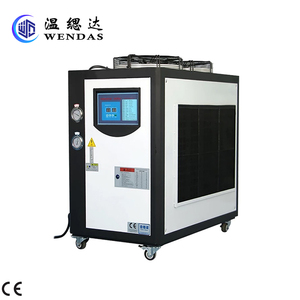




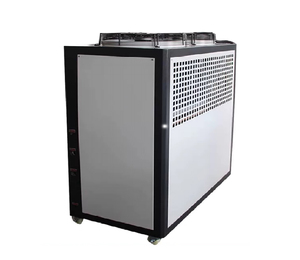






























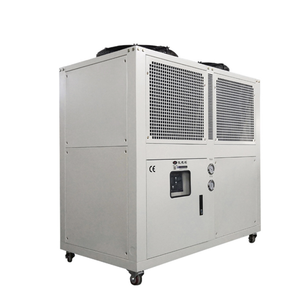

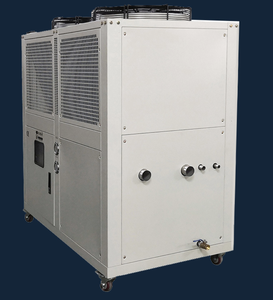
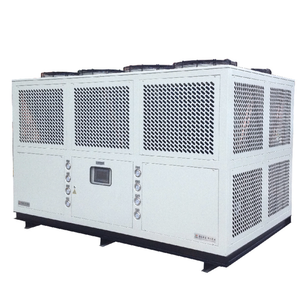
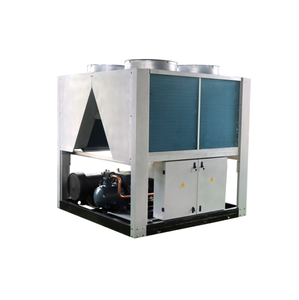
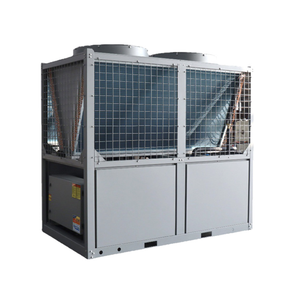













































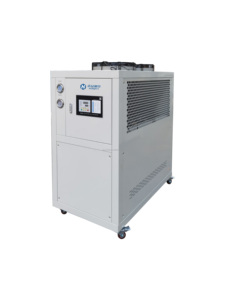







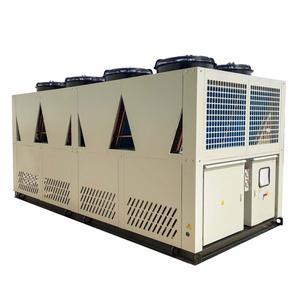

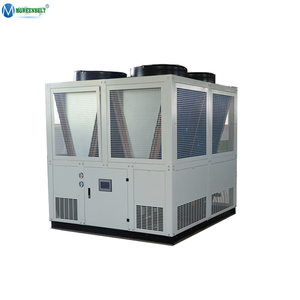



































































A 30hp water chiller is a machine used to remove heat from water through the vapor-compression or vapor-absorption refrigeration cycle. Chillers are typically used in large industries to cool processes and equipment and to provide comfort cooling in commercial buildings. In general, water chillers can be divided into two categories: the air-cooled chiller and the water-cooled chiller.
Air-cooled chiller:
An air-cooled chiller is a chiller that uses ambient air to dissipate heat and reject heat from the refrigerant. Basically, an air-cooled chiller consists of a compressor, condenser, evaporator, and other auxiliary parts. When it is working, the refrigerant in the evaporator absorbs the heat from the water and cools the water, which is then circulated back to the target area for cooling. After that, the heated refrigerant is sent to the condenser. Then, the ambient air blowing over the condenser fin coils removes the heat from the refrigerant. Finally, the cooled liquid refrigerant flows back to the evaporator to repeat the cycle.
An air-cooled chiller has several remarkable features. First, users can easily install it without extra cooling towers or condensers. Second, it doesn't need a large amount of water for heat exchange, making it ideal for places with limited water resources. Third, air-cooled chillers are generally more cost-effective than their water-cooled counterparts. However, air-cooled chillers are considerably less efficient and more suitable for small to medium-sized applications.
Water-cooled chiller:
Water-cooled chillers are refrigeration systems designed to remove heat from water through a cooling process. Unlike air-cooled chillers that use ambient air as the cooling medium, water-cooled chillers utilize water as a heat-absorbing substance to extract heat from the refrigerant. Essentially, a water-cooled chiller consists of a compressor, condenser, evaporator, coolant pump, and tower, etc. The working principle of water-cooled chillers is pretty straightforward. The refrigerant absorbs heat from the water in the evaporator and cools the water. After that, the heated refrigerant is sent to the condenser. A cooling tower can remove heat from the refrigerant. The cooled water circulates back to the evaporator of the cooling tower to continue the process.
Water-cooled chillers usually perform better than air-cooled ones, even though their initial costs may be low. This is mainly because of the high heat exchange efficiency of water. Due to higher heat transfer rates, water-cooled chillers tend to have higher cooling capacities and efficiencies.
Cooling capacity:
Cooling capacity refers to the actual refrigeration capacity of the chiller, usually expressed as the amount of heat removed per unit of time. The unit is usually tons or kW. For 30hp chillers, the cooling capacity typically ranges between 100kw and 200kw.
Power supply:
Power supply refers to the voltage and phase of the electrical power required by the chiller. For large horsepower chillers, three-phase power is usually required to ensure stable operation of the equipment.
Size and weight:
Chillers come in various forms, such as vertical or horizontal, and their size and weight depend on the design and configuration of the equipment. Generally, they are large pieces of equipment that require appropriate space and support facilities.
Refrigerant:
Chillers use a specific refrigerant to perform the refrigeration cycle. The type of refrigerant may vary according to the model and design of the equipment. Common refrigerants include R134a, R410A, etc.
Regular inspections:
Perform regular inspections of the 30hp water chiller according to the prescribed schedule to ensure that the internal and external parts of the equipment are in good condition. Inspect the electrical systems, cooling systems, and control components to identify any signs of wear, loose parts, or faults and to resolve them in a timely manner.
Clean the condenser and evaporator:
The function of the condenser and evaporator is critical to the operation of the chiller, so it is essential to keep them clean. Follow the specified method and procedure to remove dirt and deposits from the surface of the heat exchangers to ensure that the heat exchange efficiency is maintained. This will enable the equipment to operate at optimal performance and energy efficiency.
Replace refrigerants and oils:
The refrigerant and lubricating oil are both vital to the functioning of the chiller. Establish a replacement schedule and ensure that the above substances are replaced on schedule according to the requirements in order to maintain the stable operation and heat exchange efficiency of the equipment.
30 hp water chillers are common across various industries. Here are some of the industries and applications where 30 hp chillers are utilized.
Food processing and beverage industry
A food industrial fridge chiller is used to maintain product freshness and quality in the food processing and beverage industry. It cools and preserves perishable food items such as meat, dairy, and produce. It also controls fermentation, ripening, and brewing processes.
Plastic and rubber manufacturing
Plastic injection molding chiller machines are used to regulate temperatures in the injection molding industry. They are also used to cool extruders, blow molding machines, and thermoforming equipment. Cooler molds improve cycle times and enhance the dimensional stability of molded plastic products.
Medical and pharmaceutical industry
In the pharma industry, a water chiller machine is used to store drugs at cool temperatures. It also controls the temperature in critical processes such as fermentation, culturing, and enzyme reactions within cleanrooms and laboratories.
Laser and imaging systems
A laser chiller is used to maintain optimal temperature conditions for reliable operation and precise imaging capabilities. It also prevents overheating of the laser tube and ensures consistent laser beam output.
HVAC systems
An air conditioning chiller is used for central air conditioning systems in commercial buildings, offices, and facilities. It cools large quantities of water that are then circulated through air handling units and cooling coils to extract heat from the indoor air, thereby lowering room temperatures.
Metal fabrication and finishing
In metal machining sites, a water chiller can be used to cool down cutting tools during machining. This increases tool life and maintains the quality of metal workpieces.
Printing and packaging
In the printing industry, an inline chiller is used to cool printing presses and ensure stable ink viscosity and adherence to paper. It also prevents overheating of electronic components within the printing machinery.
Selecting the suitable 30hp water chilling unit for a specific requirement entails considering various aspects. Initially, it is crucial to ascertain the vital factor, cooling capacity. This should match the load's heat rejection needs. Next, operating conditions such as the facility's ambient temperature and desired chilled water temperature should be considered. Also, the type of coolant conveyed should be taken into account, as discussed earlier in this context.
When choosing a 30hp water chiller, the thing to focus on is the machine's efficiency. Chillers are generally categorized by their Energy Efficiency Ratio (EER), which indicates how well they convert energy into cooling. Choosing a high EER ratio machine can save a lot of money on operating costs in the long run.
Another important thing to note is that one should choose a model with sufficient airflow. The water chiller's capacity can be limited by the amount of air it can exchange, so models with greater airflow should be considered. Durability of the machine should also be considered. Cooling equipment usually has to withstand loads of years of usage, so chillers made with extra-strong materials with long-lasting qualities should also be chosen for longer-lasting value.
Finally, it is always important to check warranty and support services. When buying the water chiller, one should make sure to select the supplier who offers high quality product with great after-sales technical support. Also, choose the one with long warranty period to ensure peace of mind and customer support.
Q1 What is the life expectancy of a water chiller?
A1 The average life of water cooling machinery is about 20 years; however, with proper maintenance, a water cooler can last for over 30 years.
Q2 What type of water chiller is suitable for a business?
A2 Industrial water chillers are suitable for most business requirements. There are various types of industrial chillers, such as air-cooled, water-cooled, and evaporative cooling.
Q3 What type of coolant is used in a water chiller?
A3 Water or aqueous solution is used as a coolant in a water chiller. Chill water is generally circulated in the system using a pump.
Q4 How do businesses benefit from water chillers?
A4 Industries benefit from chillers as they are able to control the temperature required for production, increase efficiency and reduce energy costs.
Q5 What is the difference between air coolers and water coolers?
A5 Water-cooled chillers are more efficient than air-cooled chillers; however, air-cooled chillers require less maintenance and can be used in small facilities.